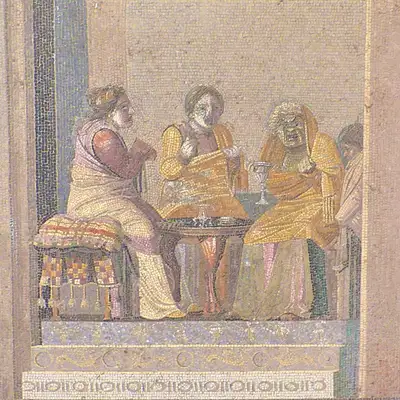This week’s post is inspired by a random question which was sent to me via WhatsApp by a student:
Hi! I’m doing my Latin GCSE next week, and I was wondering … how to recognize the historic present, as I’ve tried to simply learn the words in Sagae Thessalae however thats not quite working and I was wondering if there were any specific sign posts to signify that it is the use of the historic present. Thank you!!
Students do find historic presents hard to spot and I believe there are a variety of reasons for this. Firstly, something we Latin teachers perhaps fail to address is that students are specifically taught by their English teachers that a change of tense is a very bad thing. They get marked down for it. In the ancient world, by contrast, a switch in tense was considered fine writing and done for deliberate effect; I do wonder whether the modern view that it is poor writing inhibits our students in their ability to respond to it.
A technical reason students find it hard is that most of them are not taught morphology in detail. Certainly I did not have the teaching time to enlighten students as to the details of all five conjugations and how their stems change, so students’ ability to spot the difference between a present tense of a 3rd or mixed conjugation verb and its perfect tense, and indeed the difference between a present tense verb and the future tense of the 3rd, 4th and mixed conjugations will probably be hazy.
One possible approach is to scrupulously translate historic presents in the present tense, but given our modern disquiet with switching tenses this can end up spoiling the narrative as a whole in translation. Another solution is to mark them up in the text, and the version of Sagae Thessalae which I have borrowed and adapted from the inimitable Mark Wilmore does exactly that – all historic presents are marked with an asterisk.
It is important for students to bear in mind that not every present tense verb will be in the historic present. A historic present is defined as a change into the present tense when the narrative is taking place in the past. As a general rule, therefore, direct speech doesn’t count, as the present tense is probably simply a report of exactly what was said. Nor does it count if the entire narrative is written in the present tense, although of course if an author decides to write an entire narrative in the present, then that in itself is done for effect. But what you’re looking out for for the historic present is a sudden switch into the present tense within a past-tense narrative. This is done deliberately to make the scene vivid.
Given the imminence of the literature examinations and the fact that this student who contacted me is probably not the only one struggling with this, I have decided to do a quick sweep of the main set texts and point out the historic presents in them. This week I am looking at the prose, which is being examined on May 26th – I will look at the verse texts next week and the week after.
Examples of the historic present in Pythius
Most of Pythius is written in the past tense, but a series of historic present tense verbs towards the end highlight Canius’s bewilderment and panic as he realises he’s been conned: invitat Canius postridie familiares suos. venit ipse mature. cumbam nullam videt. quaerit a proximo vicino num feriae piscatoram essent: on the next day, Canius invites his close friends; he himself comes over early; he seems not one fishing boat; he asks his nextdoor neighbour whether it was a fishermen’s holiday. Note that three of the verbs are promoted also, which further strengthens the vivid effect.
Examples of the historic present in Sagae Thessalae
Sagae Thessalae is peppered with verbs in the historic present; below is a summary of them:
- medio in foro senem conspicio: I catch sight of an old man in the middle of the forum.
- animum meum commasculo: I strengthen my spirit. Actually the verb means something like “make manly” – Thelyphron actually tells himself to “man up”.
- et statim me perducit ad domum quandam: he leads me at once to a certain house. perducit is also a compound verb – the preposition per glued onto the front of it also makes the action more vivid.
- ubi demonstrat matronam flebilem: where he points out a weeping woman.
- mustela terga vertit et a cubiculo protinus exit: the weasel turns its back and goes out of the bedroom immediately.
- somnus tam profundus me repente demergit: a sleep so deep suddenly overwhelms me.
- cadaver accuro: I run over to the corpse.
- omnia diligenter inspicio: nihil deest: I carefully inspect everything: nothing is missing.
- ecce! uxor misera flens introrumpit: look! The wretched wife burst bursts in, weeping. Here you could talk about the emphatic interjection ecce! as well as the historic present verb.
- reddit sine mora praemium: she hands over my reward without delay. Here you could mention the fact that the verb is promoted as well as in the historic present.
- immitto me turbae: I push my way into the crowd. Here again you could mention the fact that the verb is promoted as well as in the historic present.
- et surgit cadaver et profatur: and the corpse rises up [and] speaks out. The use of polysyndeton (repeated conjunctions/connectives) further dramatises these historic presents.
- respondet ille de lectulo et … populum sic adloquitur: he responds thus from the bier and addresses the people in this way. The first of these two historic presents is promoted also.
- igitur ignarus exsurgit … ianuam adit: therefore he unwillingly gets up … [and] goes to the door.
- sagae ceram … ei applicant nasumque …. comparant: the witches attach wax to him and fit on a nose.
- temptare formam incipio. manu nasum prehendo: sequitur; aures pertracto: deruunt: I begin to examine my appearance. With my hand I grasp my nose: it comes off. I touch my ears. They fall off. Here you could talk about the tightly-packed sequence of historic presents. I would also mention the literal meaning of sequitur – his nose “follows” his hand as he takes it away from his face.
- et dum turba … me denotat … effugio: and while the crowd identifies me … I make my escape. Mention also that denotat is a compound verb.








